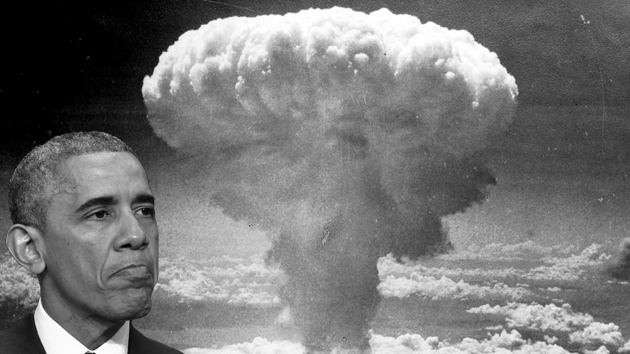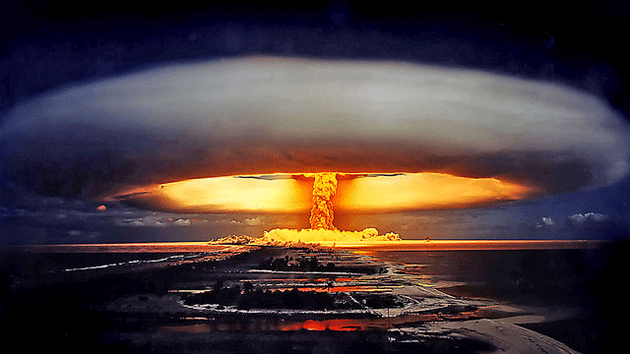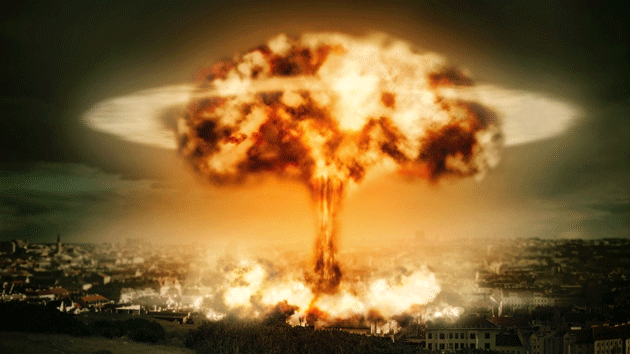
Yin Bogu/Zuma Press
This story first appeared on the TomDispatch website.
Mark these days. A long-dreaded transformation from hope to doom is taking place as the United States of America ushers the world onto the no-turning-back road of nuclear perdition. Once, we could believe there was another way to go. Indeed, we were invited to take that path by the man who is, even today, overseeing the blocking of it, probably forever.
It was one of the most stirring speeches an American president had ever given. The place was Prague; the year was 2009; the president was the recently sworn in Barack Obama. The promise made that day is worth recalling at length, especially since, by now, it is largely forgotten:
“As the only nuclear power to have used a nuclear weapon, the United States has a moral responsibility to act… So today, I state clearly and with conviction America’s commitment to seek the peace and security of a world without nuclear weapons. I’m not naive. This goal will not be reached quickly—perhaps not in my lifetime. It will take patience and persistence. But now, we, too, must ignore the voices who tell us that the world cannot change. We have to insist, ‘Yes, we can…'”
President Obama had been in office only three months when, boldly claiming his place on the world stage, he unequivocally committed himself and his country to a nuclear abolition movement that, until then, had at best existed somewhere on the distant fringes of power politics. “I know,” he added,
“that there are some who will question whether we can act on such a broad agenda. There are those who doubt whether true international cooperation is possible… and there are those who hear talk of a world without nuclear weapons and doubt whether it’s worth setting a goal that seems impossible to achieve. But make no mistake. We know where that road leads.”
The simple existence of nuclear weapons, an American president declared, paved the road to perdition for humanity.
Obama as The Captain Ahab of Nuclear Weapons
At that moment, the foundations for an imagined abolitionist world were modest indeed, but not nonexistent. The 1968 Nuclear Non-Proliferation Treaty (NPT) had, for instance, struck a bargain between nuclear haves and have-nots, under which a path to abolition was treated as real. The deal seemed clear enough: the have-nots would promise to forego obtaining nukes and, in return, the world’s reigning nuclear powers would pledge to take, in the words of the treaty, “effective measures in the direction of nuclear disarmament.”
For decades before the Obama moment, however, the superpower arsenals of nuclear warheads continued to grow like so many mushrooms, while new nuclear states—Israel, Pakistan, India, North Korea—built their own impressive arsenals. In those years, with the singular exception of South Africa, nuclear-weapons states simply ignored their half of the NPT bargain and the crucial clause mandating progress toward eventual disarmament was all but forgotten.
When the Cold War ended in 1991 with the disappearance of the Soviet Union, and the next year Americans elected as president Bill Clinton, who was famously against the Vietnam War, it was at least possible to imagine that nukes might go the way of internationally banned chemical weapons. But Washington chose otherwise. Despite a paucity of enemies anywhere on Earth, the Pentagon’s 1994 Nuclear Posture Review insisted on maintaining the American nuclear arsenal at Cold War levels as a “hedge,” an insurance policy, against an imagined return of Communism, fascism, or something terrible in Russia anyway—and Clinton accepted the Pentagon’s position.
Soon enough, however, even prominent hawks of the Cold War era began to worry that such a nuclear insurance policy could itself ignite a global fire. In 1999, a chief architect of the nuclear mindset, Paul Nitze, stepped away from a lifetime obsession with building up nuclear power to denounce nukes as “a threat mostly to ourselves” and to explicitly call for unilateral disarmament. Other former apostles of nuclear realpolitik also came to embrace the goal of abolition. In 2008, four high priests of the cult of nuclear normalcy—former Senator Sam Nunn, former Secretary of Defense William J. Perry, and former Secretaries of State George Schultz and Henry Kissinger—jointly issued a sacrilegious renunciation of their nuclear faith on the Wall Street Journal‘s editorial page. “We endorse setting the goal of a world free of nuclear weapons,” they wrote, “and working energetically on the actions required to achieve that goal.”
Unfortunately, such figures had come to Jesus only after leaving office, when they were exempt from the responsibility of matching their high-flown rhetoric with the gritty work of making it real.
Obama in Prague was another matter. He was at the start of what would become an eight-year presidency and his rejection of nuclear fatalism rang across the world. Only months later, he was awarded the Nobel Peace Prize, in large part because of this stunning commitment. A core hope of the post-World-War-II peace movement, always marginal, had at last been embraced in the seat of power. A year later, at Obama’s direction, the Pentagon, in its 2010 Nuclear Posture Review, actually advanced the president’s purpose, committing itself to “a multilateral effort to limit, reduce, and eventually eliminate all nuclear weapons worldwide.”
“The United States,” that document promised, “will not develop new nuclear warheads.” When it came to the future of the nuclear arsenal, a program of responsible maintenance was foreseen, but no new ground was to be broken. “Life Extension Programs,” the Pentagon promised, “will use only nuclear components based on previously tested designs, and will not support new military missions or provide new military capabilities.”
Obama’s timing in 2009 was critical. The weapons and delivery systems of the nuclear arsenal were aging fast. Many of the country’s missiles, warheads, strategic bombers, and nuclear-powered submarines dated back to the early Cold War era and were effectively approaching their radioactive sell-by dates. In other words, massive reductions in the arsenal had to begin before pressures to launch a program for the wholesale replacement of those weapons systems grew too strong to resist. Such a program, in turn, would necessarily mean combining the latest technological innovations with ever greater lethality in a way guaranteed to reinvigorate the entire enterprise across the world—the polar opposite of “effective measures in the direction of nuclear disarmament.”
Obama, in other words, was presiding over a golden moment, but an apocalyptic deadline was bearing down. And sure enough, that deadline came crashing through when three things happened: Vladimir Putin resurfaced as an incipient fascist intent on returning Russia to great power status; extremist Republicans took Congress hostage; and Barack Obama found himself lashed, like Herman Melville’s Captain Ahab, to “the monomaniac incarnation of all those malicious agencies which some deep men feel eating in them, till they are left living on half a heart and half a lung.” Insiders often compare the Pentagon to Moby Dick, the Great White Whale, and Obama learned why. The peaceful intentions with which he began his presidency were slapped away by the flukes of the monster, like so many novice oarsmen in a whaling skiff.
 Hence Obama’s course reversals in Iraq, Afghanistan, and Syria; hence the White House stumbles, including an unseemly succession of secretaries of defense, the fourth of whom, Ashton Carter, can reliably be counted on to advance the renewal of the nuclear force. The Pentagon’s “intangible malignity,” in Melville’s phrase, was steadily quickened by both Putin and the Republicans, but Obama’s half-devoured heart shows in nothing so much as his remarkably full-bore retreat, in both rhetoric and policy, from the goal of nuclear abolition.
Hence Obama’s course reversals in Iraq, Afghanistan, and Syria; hence the White House stumbles, including an unseemly succession of secretaries of defense, the fourth of whom, Ashton Carter, can reliably be counted on to advance the renewal of the nuclear force. The Pentagon’s “intangible malignity,” in Melville’s phrase, was steadily quickened by both Putin and the Republicans, but Obama’s half-devoured heart shows in nothing so much as his remarkably full-bore retreat, in both rhetoric and policy, from the goal of nuclear abolition.
A recent piece by New York Times science correspondent William J. Broad made the president’s nuclear failure dramatic. Cuts to the US nuclear stockpile initiated by George H.W. Bush and George W. Bush, he pointed out, totaled 14,801 weapons; Obama’s reductions so far: 507 weapons. In 2010, a new START treaty between Moscow and Washington capped future deployed nukes at 1,500. As of this October, the US still deploys 1,642 of them and Russia 1,643; neither nation, that is, has achieved START levels, which only count deployed weapons. (Including stored but readily re-armed and targeted nukes, the US arsenal today totals about 4,800 weapons.)
In order to get the votes of Senate Republicans to ratify the START treaty, Obama made what turned out to be a devil’s bargain. He agreed to lay the groundwork for a vast “modernization” of the US nuclear arsenal, which, in the name of updating an aged system, is already morphing into a full-blown reinvention of the arms cache at an estimated future cost of more than a trillion dollars. In the process, the Navy wants, and may get, 12 new strategic submarines; the Air Force wants, and may get, a new long-range strike bomber force. Bombers and submarines would, of course, both be outfitted with next-generation missiles, and we’d be off to the races. The arms races.
All of this unfolds as Vladimir Putin warms the hearts of nuclear enthusiasts everywhere not only by his aggressions in Ukraine, but also by undercutting the landmark 1987 Intermediate-Range Nuclear Forces Treaty by testing a new ground-launched cruise missile. Indeed, just this fall, Russia successfully launched a new intercontinental ballistic missile. It seems that Moscow, too, can modernize.
On a Twenty-First Century Road to Perdition
Responding to the early Obama vision of “effective measures” toward nuclear disarmament, and following up on that 2010 Nuclear Posture Review, senior Pentagon officials pursued serious discussions about practical measures to reduce the nuclear arsenal. Leading experts advocated a shift away from the Cold War’s orgasmic strike targeting doctrine that still necessitates an arsenal of weapons counted in the thousands.
In fact, in response to budget constraints, legal obligations under a jeopardized non-proliferation treaty, and the most urgent moral mandate facing the country, America’s nuclear strategy could shift without wrenching difficulty, at the very least, to one of “minimal deterrence.” Hardcore national security mavens tell us this. Such a shift would involve a reduction in both the deployed and stored nuclear arsenal to something like 500 warheads. Even if that goal were pursued unilaterally, it would leave more than enough weaponry to deter any conceivable state-based nuclear threat, including Russia’s, no matter what Putin may do.
Five hundred is, of course, a long way from zero and so from the president’s 2009 goal of abolition, and yet opposition even to that level would be fierce in Washington. Though disarming and disposing of thousands of nukes would cost far less than replacement, it would still be expensive, and you can count on one thing: Pentagon nuclearists would find firm allies among congressional Republicans, who would be loathe to fund such a retreat from virtue’s Armageddon. Meanwhile, confronting such cuts, the defense industry’s samurai lobbyists would unsheathe their swords.
But if a passionate Obama could make a compelling case for a nuclear-free world from Prague in 2009, why not go directly to the American people and make the case today? There is, of course, no sign that the president intends to do such a thing any longer, but if a commander-in-chief were to order nuclear reductions into the hundreds, the result might actually be a transformation of the American political conscience. In the process, the global dream of a nuclear-free world could be resuscitated and the commitment of non-nuclear states (including Iran) to refrain from nuclear-weapons development could be rescued. Most crucially, there would no longer be any rationale for the large-scale reinvention of the American nuclear arsenal, a deadly project this nation is even now preparing to launch. At the very least, a vocal rededication to an ultimate disarmament, to the actual abolition of nuclear weapons, would keep that road open for a future president to re-embark upon.
Alas, Pentagon advocates of “minimal deterrence” have already been overridden. The president’s once fiercely held conviction is now a mere shadow of itself. As happened with Ahab’s wrecked whaling ship, tumultuous seas are closing over the hope that once seized the world’s attention. Take it for granted that, in retirement and out of power, ex-president Obama will rediscover his one-time commitment to a world freed from the nuclear nightmare. He will feel the special responsibility proper to a citizen of “the only nuclear power to have used a nuclear weapon.” The then-former president’s speeches on the subject will be riveting and his philanthropy will be sharply targeted. All for naught.
Because of decisions likely to be taken this year and next, no American president will ever again be able to embrace this purpose as Obama once did. Nuclear weapons will instead become a normalized and permanent part of the twenty-first century American arsenal, and therefore of the arsenals of many other nations; nuclear weapons, that is, will have become an essential element of the human future—as long as that future lasts.
So yes, mark these days down. Nuclear abolition itself is being abolished. Meanwhile, let us acknowledge, as that hopeful young president once asked us to, that we know where this road leads.
James Carroll is a Boston Globe columnist and Distinguished Scholar-in-Residence at Suffolk University. He is the author, among other works, of House of War: The Pentagon and the Disastrous Rise of American Power and, most recently, Christ Actually: The Son of God for the Secular Age. To stay on top of important articles like these, sign up to receive the latest updates from TomDispatch.com here.















